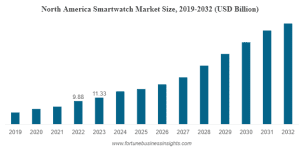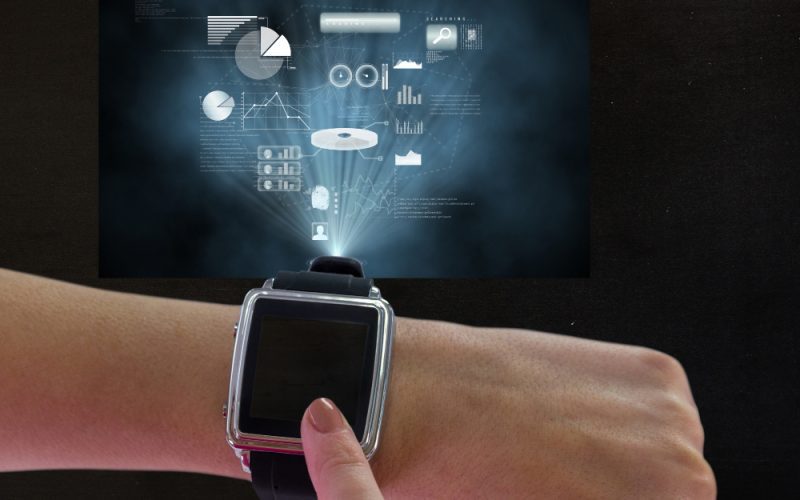The global smartwatch market has been experiencing unprecedented growth. Valued at USD 29.31 billion in 2023, it is projected to escalate from USD 33.58 billion in 2024 to an astounding USD 103.61 billion by 2032, exhibiting a compound annual growth rate (CAGR) 15.12% during the forecast period. With North America leading the charge, holding a market share of 38.66% in 2023, this dynamic market shows no signs of slowing down.
Growing Consumer Inclination Towards Tech Products

Consumer Demand for Multifunctional Devices
The rising consumer inclination towards technological devices, particularly smartwatches, is driven by the manifold benefits they offer. These devices simplify life with attributes like navigation, fitness tracking, and seamless notification checking. From athletes and tech enthusiasts to everyday users, smartwatches cater to a broad spectrum of needs. Key brands are continuously innovating, offering advanced wristwatches to woo consumers. For instance, Xiaomi launched their S1 Pro series in August 2022, packed with Real Time OS (RTOS) and compelling features, unlocking new market growth opportunities.
Impact of COVID-19 on the Smartwatch Market
The COVID-19 pandemic had a twofold impact on the smartwatch market. While lockdown measures and social distancing protocols temporarily shuttered retail outlets and curtailed foot traffic in shopping malls, the pandemic also underscored the importance of health and fitness tracking. This shift drove demand for smartwatches equipped with advanced health monitoring capabilities, enabling users to track metrics such as heart rate, activity levels, sleep patterns, and even potential COVID-19 symptoms.
Smartwatch Market Trends
Focus on Kids and Health Features
Key companies are increasingly targeting younger demographics by manufacturing smartwatches specifically designed for kids. This pivot is set to drive market growth. The GOQii smart vital junior wristwatch, launched in June 2021, exemplifies this trend with its 18 activity modes aimed at keeping children physically active.
Fitness and Urbanization Fueling Market Progression
The escalating interest in fitness among the youth and the growing urban population are propelling the smartwatch market forward. According to the United Nations, 56.61% of the world’s population lived in urban areas in September 2021, a figure expected to rise to 68% by 2050. This urban shift exposes more individuals to smart devices, increasing their adoption.
High Spending Power of Developed Economies
The robust consumer spending power in developed economies significantly boosts smartwatch sales. High per capita income encourages consumers to spend more on tech products, including smartwatches. For example, Luxembourg’s GDP per capita was recorded at USD 115,683 in December 2021, driving substantial market growth.
Challenges in the Smartwatch Market
Presence of Substitute Products
Traditional wristwatches maintain a strong presence and sentimental value among consumers, posing a challenge to smartwatch penetration. While smartwatches offer advanced functionalities, some consumers still prefer the classic design and simplicity of traditional watches. This preference, prevalent among high-, middle-, and low-income demographics, could potentially hamper smartwatch market growth.
Smartwatch Market Segmentation Analysis

iOS Operating Systems
The iOS segment is anticipated to dominate the market due to the strong penetration of Apple products, which feature advanced iOS operating systems. Technological advancements in iOS further bolster this segment’s growth.
Android and Others
While iOS holds a dominant position, the Android and other segments are also gaining traction. These segments appeal to a broader range of consumers, including those with lower purchasing power, by offering a variety of affordable options.
By End-User
Male Segment
The male segment dominates the smartwatch market, driven by a significant number of male tech enthusiasts willing to spend more on tech products compared to women.
Female Segment
The female segment has witnessed considerable growth due to the increasing production of women-specific smartwatch designs. Garmin Lily’s women’s wristwatch, launched in March 2021 with a pregnancy tracker, is a prime example of this trend.
By Application
Running Segment
The running segment holds a prominent market share, driven by its popularity and ease of access as a form of exercise. The growing awareness of running’s health benefits among youngsters further supports demand for running-specific smartwatches.
Other Applications
Other applications, including checking notifications, swimming, and cycling, have also seen significant development. Working professionals use smartwatches for notifications, while outdoor activity enthusiasts use them to enhance their skills, boosting segment usage.
Regional Insights

North America
North America leads the smartwatch market, boasting a market size of USD 11.33 billion in 2023. The region’s high consumer expenditures on tech products and the elderly population’s increased spending on smartwatches play vital roles in market growth.
Europe
Europe is expected to witness significant growth due to its low youth unemployment rate and high disposable income. The region’s youth, inclined towards smart wearables, further fuels market demand.
Asia Pacific
Rising disposable incomes in emerging Asian economies are propelling smartwatch demand, particularly among middle and lower-income populations. Affordable smartwatch production by companies like Xiaomi boosts market growth in this region.
South America
South America is showing considerable growth, driven by the booming e-commerce sector. Rapid e-commerce expansion encourages more consumers to invest in smart electronic goods.
Middle East and Africa
Economic progress and rising disposable incomes in the Middle East and Africa contribute to regional smartwatch market growth. Increased spending by the population on tech products also boosts market development.
Key Players and Market Developments
Health-Related Features for Competitive Edge
Companies in the smartwatch market are increasingly focusing on health-related features to gain a competitive edge. This trend raises awareness about personal health and wellness, driving demand for smartwatches as health monitoring tools. Withings launched a cardiac-monitoring wristwatch in September 2021, highlighting this focus.
Major Companies in the Market
- Apple Inc. (U.S.)
- The Samsung Group (South Korea)
- Garmin Ltd. (U.S.)
- Fitbit LLC (U.S.)
- Huawei Technologies (China)
- Fossil Group, Inc. (U.S.)
- Polar Electro (Finland)
- ASUSTek Computer Inc. (Taiwan)
- LG Electronics (South Korea)
- Xiaomi Inc. (China)
Recent Industry Developments
- Apple Inc. launched its ‘Series 8 and Apple Watch SE’ in September 2022, featuring innovative health benefits and advanced technology.
- Samsung Electronics introduced the ‘Galaxy Watch5 and Galaxy Watch5 Pro’ in August 2022, equipped with advanced features suited for tracking health and wellness.
- Fitbit LLC released the ‘Fitbit Sense 2’ smartwatches in August 2022, incorporating sensors to track stress, heart health, and fitness.
- boAt launched the ‘Watch Xtend Pro and Wave Call’ in August 2022, featuring advanced tools like speakers, calling functions, and sports modes.
- Garmin Ltd. announced the Venu 2 Plus and Vivomove Sport series in January 2022, reinforcing its smartwatch lineup.
Conclusion
The smartwatch market is on a robust growth trajectory, driven by technological advancements, growing consumer inclination towards health and fitness, and increasing disposable incomes in developing regions. Companies are focusing on innovation and catering to niche segments, such as kids and women, and emphasizing health-monitoring features to capture market share. Despite challenges from traditional watches, the smartwatch market shows immense potential for growth in the coming years, promising new opportunities for both established players and new entrants.
By understanding these market dynamics and leveraging emerging trends, stakeholders can capitalize on the burgeoning smartwatch market and contribute to its continuous evolution.












